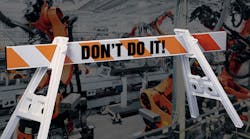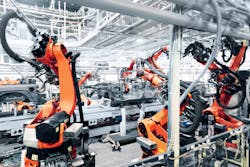When the payload is low and the task simple, it may seem reasonable to build your own robot. However, by not involving a robotics expert in the robot development process, electronics designers and manufacturers set themselves up for some severe consequences.
Why Do Manufacturers Try to Do It on Their Own?
Moving around lightweight wafer and circuit boards isn’t a complicated task and requires only very simple grippers—grippers that aren’t welding or cutting. However, most commercial and industrial robots have features and payloads to accommodate more complicated tasks. These unnecessarily complicated robots tend to be much more expensive than what’s required for electronics design applications.
Because of this, many electronics manufacturers might think it’s smarter to just build their own robot. And they generally have two defenses for this approach: the robot will be less expensive, and it can be fully customized to their specific application.
Building Your Own Robot is a Risk
The idea that it’s simple to develop robots for repetitive or mundane tasks is a dangerous misconception. While initially it may seem like a fiscally smart idea to build a robot yourself, the risks quickly outweigh the benefits.
- Safety: Due to the volume of standards and guidelines surrounding the development of collaborative robots, it’s very difficult for someone untrained to get it right. Robotics experts look at the whole picture: the environment, workers, applications, etc. They know the pitfalls and what to look out for in order to avoid dangerous mistakes. Experts also know which parts to buy at a lower cost and those that must be bought at higher prices to avoid failing. They design for longevity, which translates to less failure, greater ROI, and a safer robot overall.
- Upgrades: When manufacturers decide to build their own robot, it tends to be something that’s difficult to upgrade for future applications. It’s unlikely that specific abilities will transfer over to anything else or integrate with any other facility applications. For example, if a company builds a robot for a light payload but then decides it needs the robot to lift heavier things, the robot will have no ability to do that. That means, while this first robot may have been a less expensive option up front, the fact that another robot is necessary for a similar task with only a slightly different payload negates any of the cost savings. When experts build robots, they create something that’s general purpose, fits many applications, and aids in ROI.
- Robustness: When building a robot with the goal of saving money, robustness often takes a backseat—or isn’t considered at all. Creating a robot that has commercial robustness from a functionality standpoint, something that won’t break down every other week, is much harder than it sounds. If the robot isn’t improving facility processes for the long term and can’t adapt to new processes, it’s a bad investment. Again, while the per unit cost might be lower to build in-house, the overall development process costs are much higher. Without robotic expertise, electronics manufacturers run the risk of building a robot that doesn’t work effectively and may end up being a waste of money.
The Major Benefits of Partnering with an Expert
Safety is a clear and important benefit of partnering with a robotics expert. It takes lots of experience to create a robot that people can safely interact with. And if you’re not an expert, you won’t be looking at the entire picture needed to ensure that.
Robotics experts also have the benefit of product lines. A portfolio of robots means that when manufacturers need to change facilities or the robot use case, it’s an easy switch. The employees who do programming in-house no longer have to learn an entirely new language just to switch a robot’s use. Instead, they can quickly deploy a larger robot or one of a different style with little cost or effort on the development side.
Those who don’t work in robotics generally lack a clear idea of what they actually need in a robot. They may not know the features required beyond payload or reach and therefore don’t fully understand what they need to build and why they’re building it. Even with all of their experience, manufacturers may get down to the final development process and realize that they overlooked a particular aspect.
Such a risk is much higher for those who have never engineered a robot before. Experts have the know-how and skill from working across industries and may even have solutions that work better than the original plan, leaving customers who choose to do it on their own at a disadvantage because they’re not in that industry.
Working with the right partner means access to someone with extensive experience in robotic development, application, and maintenance. This expertise is critical to creating something that functions without failure and is designed for longevity. While lower costs might be appealing, a robust, well-developed robot is a more profitable, long-term investment for any facility.
Corey Ryan is the manager for medical robotics at KUKA Robotics.


